
Latest News
- Hyundai E&C Strengthens Korea-Japan Cooperation in Energy Transition and New Growth Businesses
- Hyundai E&C Signals Green Light for Large-Scale Nuclear Power Plant Business in Europe
- Hyundai E&C Unveils Energy-driven Growth Strategy “H-Road”
- Hyundai E&C to Build First Unit of SMR-300, a Model for U.S.-Korea Energy Cooperation
- Hyundai E&C Awarded ‘Gold Winner’ at the Asia Design Prize 2025
How Did Hyundai E&C Become a Leader in K-Construction?
In the Era of $1 Trillion in Cumulative Overseas Construction Orders:
How Did Hyundai E&C Become a Leader in K-Construction?

The cumulative value of overseas construction orders won by Korean companies has exceeded $1 trillion. At the center of this achievement is Hyundai E&C, which has captivated the world for 59 years. How has Hyundai E&C established itself as a leader in K-construction? Let’s take a closer look at the secrets behind Hyundai E&C’s success in pioneering the global market.
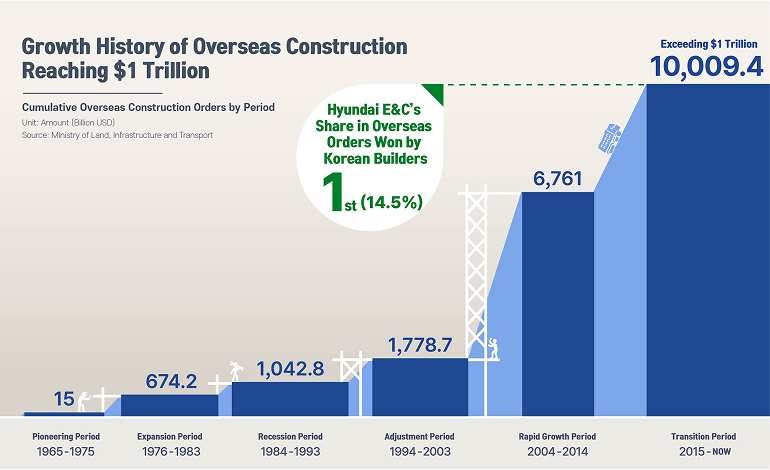
Hyundai E&C, Leading the Charge Toward USD 1 Trillion in Overseas Construction Orders
In the 1970s, when the world was shaken by the oil crisis, the “Special Demand in Middle East” emerged as a key industry that saved the Korean economy. And at the end of 2024, Korea surpassed a cumulative overseas construction order value of $1 trillion for the first time in the 59 years since recording its first overseas order in 1965. This milestone is the result of the tireless efforts of Korean construction companies and the dedication of the workers who committed themselves to overseas construction sites. At the center of this achievement is Hyundai E&C, which has been pioneering the global construction market. As the first Korean builder to go global, Hyundai E&C has solidified its position by achieving the highest total cumulative order value of USD 145.48 billion.

Leading the Way in Overseas Construction for Over Half a Century
The construction of the Narathiwat Highway in Pattani, Thailand, in 1965 marked Hyundai E&C's first overseas expansion and the first overseas order for South Korea. Since then, Hyundai E&C has steadily expanded its presence for more than half a century. Following the construction boom in the Middle East in the 1970s, the company extended its business to Southeast Asia, Latin America, and Africa. In 2013, it became the first Korean builder to achieve the unprecedented feat of surpassing USD 100 billion in cumulative overseas orders. Now, Hyundai E&C is once again moving toward an unprecedented record of surpassing USD 150 billion in cumulative overseas orders, based on the technology and experience it has accumulated in the global market.
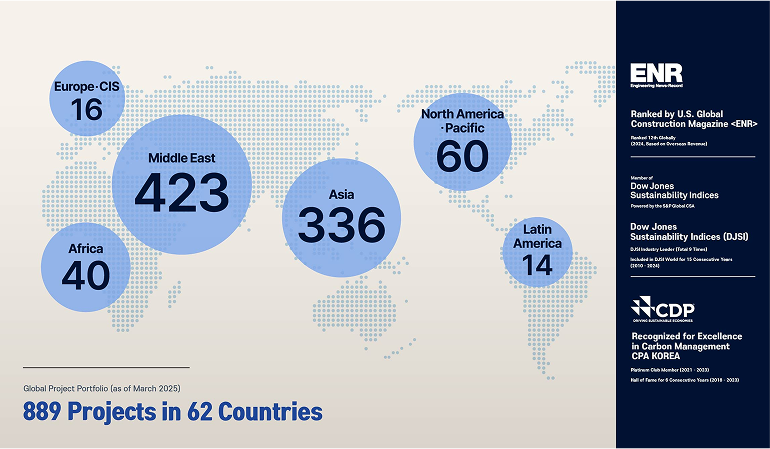
Hyundai E&C’s Footprint on the Global Stage
How many projects has Hyundai E&C carried out overseas so far? As of the end of last year, Hyundai E&C has successfully carried out 889 projects in 62 countries around the world. Breaking away from its strategy of focusing only on orders from the Middle East and Southeast Asia in the 1970s, the company is boldly expanding its business into Latin America, Europe, and Africa. What is particularly noteworthy is that while most domestic construction companies have stuck to an order-taking strategy that is heavily biased toward overseas plant construction, Hyundai E&C has built a balanced portfolio in various fields, including large nuclear power plants, petrochemical facilities, large-scale ports, and construction work.
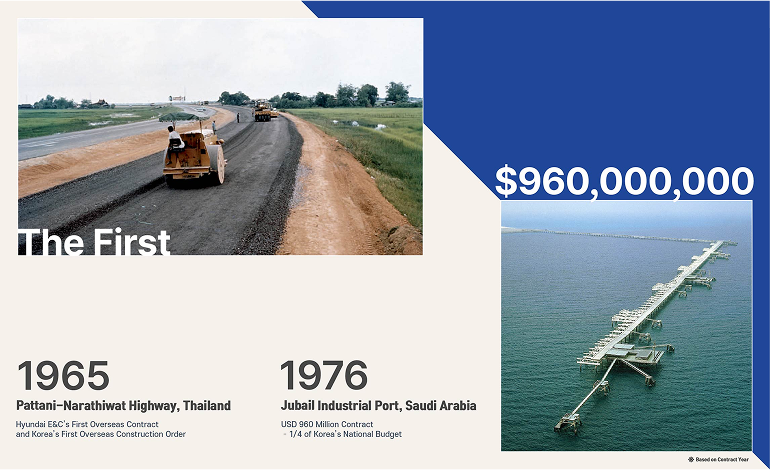
Project 1
Pattani–Narathiwat Highway, Thailand: Korea’s First Step Abroad
In 1965, Hyundai E&C successfully secured the construction of the Pattani–Narathiwat Highway in Thailand - a historic milestone as South Korea’s very first overseas construction contract. The project drew nationwide attention, to the point that when the engineers and workers gathered at the airport for the project, it was broadcast live on television due to the intense public interest. Hyundai E&C overcame various challenges, including harsh weather and unfamiliar infrastructure, and successfully completed a 98-kilometer two-lane highway. Through this project, Hyundai E&C laid a solid foundation in overseas construction by mastering the fundamentals such as applying international specifications, operating equipment, and producing asphalt concrete (ascon).
Project 2
Jubail Industrial Port, Saudi Arabia: The Beginning of the Middle East Legend
The Jubail Industrial Port project in Saudi Arabia, secured by Hyundai E&C in 1976, astonished everyone at the time. The contract amount of $960 million was equivalent to about one-fourth of Korea’s government budget at the time. This project involved the construction of a new port to support industrial facilities in the Jubail area, located in Saudi Arabia’s eastern oil-producing region, and was carried out over approximately three and a half years, from June 1976 to December 1979. Hyundai E&C successfully completed this large-scale project spanning both land and sea, significantly advancing its technological capabilities. In particular, by gaining experience and technology in the construction of offshore structures like the OSTT (Open Sea Tanker Terminal) - an area that was largely unexplored globally at the time - the company established a foothold in the offshore construction market, which had previously been monopolized by globally leading firms.
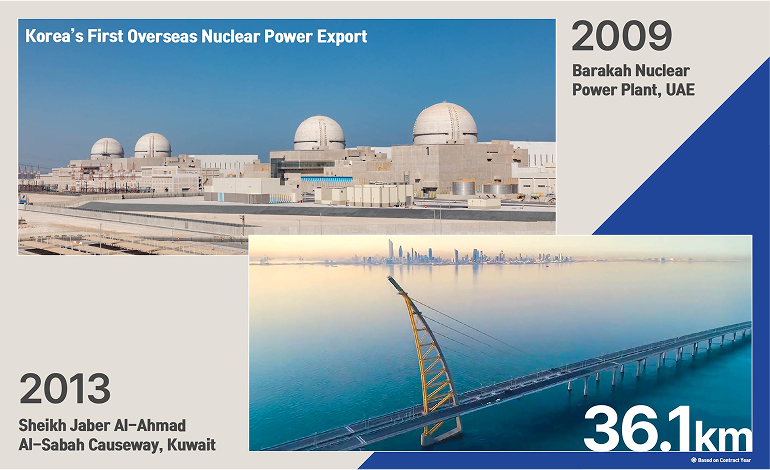
Project 3
Malaysia’s Penang Bridge: Ranked Third Largest in the World in the 1980s
The Penang Bridge in Malaysia, which Hyundai E&C won amidst fierce competition with global construction companies, was the company’s second overseas bridge project following the Alaska Hurricane Bridge. With a total length of 13.5 km - 8.5 km spanning over the sea - the bridge was completed in 1985 and was recognized as the longest in Asia and the third longest in the world at the time. The greatest challenge during construction was installing the bridge piers on soft ground. Hyundai E&C installed more than 15,000 large concrete piles (1 m in diameter and 60 m in length) into the seabed and carried out a precise process of striking each pile more than 5,000 times using a remote steam hammer. This technological challenge and success marked a turning point for Hyundai E&C in solidifying its position in the global bridge construction market.
Project 4
Suntec City: Mega Complex with Six Connected Buildings
In the 1990s, Southeast Asia emerged as the largest construction market after the Middle East. Among these countries, Singapore stands out as a place where Hyundai E&C’s footprint is so extensive that the entire nation could be considered part of its portfolio. Suntec City, which made a spectacular debut in 1997 by sweeping major architectural awards, is a representative landmark constructed by Hyundai E&C. This mega-complex, consisting of six buildings connected by a podium structure, includes four 45-story office towers, an 18-story commercial building, and a convention center. At the time, it was the largest steel-framed structure in Singapore and remains one of the country’s most iconic landmarks to this day.
.png)
Project 5
UAE Barakah Nuclear Power Plant: Pride of the K-Nuclear Power Plant Built Through Sandstorm
Four nuclear reactors were built 270 km west of Abu Dhabi, UAE, through the harsh sandstorms of the desert. The Barakah Nuclear Power Plant is the first overseas nuclear power plant constructed by Hyundai E&C and the first overseas nuclear power project for Korea, marking the beginning of a new era in the global nuclear power market. Built on a site four times the size of Yeouido (8 km wide and 1.8 km long), the Barakah Nuclear Power Plant features an 80-meter-high domed reactor building reminiscent of a mosque. Hyundai E&C carried out the construction project in accordance with the principle of “on time and on budget,” and the commercial operation of Units 1 to 4 began in 2024. Hyundai E&C, having demonstrated the technological prowess of the “K-nuclear power plant,” is further strengthening its position in the global nuclear power market by signing a design contract for the new construction of the Kozloduy Nuclear Power Plant in Bulgaria in November 2024.
Project 6
Sheikh Jaber Al-Ahmad Al-Sabah Causeway: A 36 km Masterpiece Spanning Kuwait Bay
The Sheikh Jaber Al-Ahmad Al-Sabah Causeway is a large-scale project secured by Hyundai E&C in 2013, with a total length of 36.1 km (27.5 km over sea and 8.6 km on land) and a 6-lane dual way (8 lanes including emergency lanes). At the time, the causeway was the largest overseas civil engineering project awarded to a Korean builder since the Great Man-Made River Project in Libya in 1984. Hyundai E&C applied a fast-track method that allowed for simultaneous design and construction, achieving the remarkable feat of reducing the construction period from the originally estimated 7 years to just 66 months. The highlight of the project, the main bridge (340 m), features a structure inspired by the silhouette of a traditional Kuwaiti dhow sailboat. It now stands proudly as a landmark over the vast expanse of the sea.
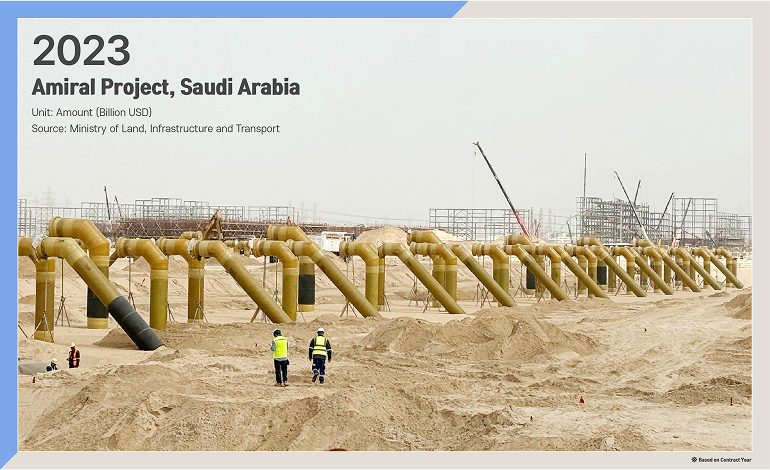
Project 7
Saudi Arabia's Amiral Project: Legend in Middle East One More Time
Since the construction of the Jubail Industrial Port in 1976, Hyundai E&C is once again creating a Middle Eastern legend in Saudi Arabia in 2023. The Amiral Petrochemical Complex Package 1 & 4, with a total project cost of USD 5 billion, is the largest petrochemical plant project in Saudi Arabia. Package 1 includes a mixed feed cracker (MFC) plant, while Package 4 encompasses major infrastructure, base facilities, and tanks for the production of high-value chemicals.
Currently, the site is in the midst of installing piping and steel structures (piperack), which are the core components of the plant’s facilities. Delivering, inspecting, and installing large-diameter underground pipes that are much taller than a person is no easy task, but Hyundai E&C is carrying out the construction with its extensive experience and accumulated technology. Through the Amiral project, Hyundai E&C plans to further strengthen the trust it has built in the Middle East over the past half-century.
Hyundai E&C is at the center of the era of USD 1 trillion overseas construction contracts. From the construction of the Pattani-Narathiwat Expressway in Thailand to the Kozloduy Nuclear Power Plant in Bulgaria, which it won last year, Hyundai E&C has built its global construction capabilities and expertise through more than 880 projects in 62 countries. Now, Hyundai E&C is moving toward a greater future. This year, Hyundai E&C plans to focus on expanding the energy value chain, developing innovative technologies and products, and promoting high-value overseas projects. Achieving USD 1 trillion in overseas construction orders from Korea marks the beginning of a new global construction legend that Hyundai E&C will create.

